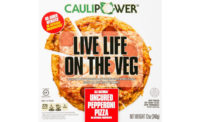Within the past few years, choices for popcorn flavors have become more diverse. In 2017, you can choose to eat popcorn straight from the bag, made in the microwave, or even drizzled with chocolate. Consumers can even choose from flavors like honey butter and ranch. For today’s popcorn fans, this category offers more snacking options than ever before.
Overview | Chips | Puffed/Extruded Snacks | Popcorn | Snack Mixes & Nuts | Tortilla Chips | Pretzels | Frozen Snacks | Crackers
Market data
Looking at data from IRI, Chicago from the past 52 weeks ending April 16, 2017, the ready-to-eat (RTE) popcorn/caramel corn segment within salty snacks continued on a nice pattern of growth, up 11.92 percent in dollar sales to $1.3 billion. The Frito-Lay RTE brand Smartfood continues to lead the segment, up a healthy 28.83 percent to $349.1 million. The better-for-you Smartfood Delight line, with 35 calories per cup, likewise saw nice growth, up 38.35 percent to $63.7 million. Skinnypop, from Amplify Snack Brands, is the No. 2 brand in the segment, up 15.96 percent to $224.8 million, per IRI. The No. 3 brand, Angie’s BOOMCHICKAPOP grew by 22.82 percent to $71.3 million.
Two brands in RTE popcorn saw significant growth for the year. The General Mills organic snack brand Annie’s Homegrown saw its popcorn dollar sales increase by 449.78 percent to $12.9 million, while the Snyder’s-Lance brand Lance popcorn rose 499.02 percent to $10.0 million.
Microwave popcorn continues to struggle, down 6.94 percent in dollar sales to $761.9 million. Kernel popcorn likewise took a hit, down 5.28 percent to $113.2 million, per IRI.
Looking back
This past year, popcorn flavors trended toward the unique and the bold. Consumers wanted variety in their popcorn choices, and snack producers stepped up to the challenge.
“Standard flavors like cheese, butter and caramel are still popular, but we’re seeing twists on these classic flavors—using Parmesan cheese instead of white or yellow Cheddar, or mixing caramel with a spicy complement like sriracha or jalapeño Cheddar,” says Josephine Nakhla, senior associate brand manager, Kraft Heinz Ingredients, Glenview, IL.
In March 2017, G.H. Cretors released three new flavors of its organic handcrafted gourmet popcorn: White Cheddar, Honey Butter Kettlecorn and Salted Butter. The company also sells flavors such as Dill Pickle and Chile Jalapeño White Cheddar.
In October 2016 and March 2017, Doc Popcorn released two new flavors—Cookies ‘n Cream, for consumers wanting a sweeter snack, and Ragin’ Ranch, for those wanting something more savory. Its Ragin’ Ranch variety combines hints of dill, garlic and vinegar. Doc Popcorn also offers a Hoppin’ Jalapeño flavor.
“Smoky, spicy and global flavors are continuing to dominate snack foods, including popcorn, driven by consumer interest in surprising and intriguing savory flavors,” explains Megan O’Keefe, marketing, SaltWorks, Woodinville, WA. “Unique flavors are truly taking over the specialty popcorn industry.”
In March 2016, the Snyder’s-Lance subsidiary Cape Cod released a Roasted Black Garlic flavor of popcorn—a flavor profile it has also applied to potato chips. The popcorn has a “mild garlic bite” and only 60 calories per cup, which allows for “guilt-free snacking.”
Angie’s BOOMCHICKAPOP has also recently released some flavor-forward options, including a Sweet Barbeque flavor. In January 2017, the company released five new flavors, including Dark Chocolatey Drizzled Sea Salt Kettle Corn and Milk Chocolaty Peanut Butter Flavored Kettle Corn.
Indulgent-leaning popcorn is hot right now. Both The Little Kernel’s S’mores popcorn and Zebra by Popcornopolis were released in March 2017. S’mores popcorn has a “toasty, chocolately, marshmallow-y taste,” and is popped with 100 percent olive oil; it is also non-GMO and dairy-free. Zebra by Popcornopolis is available in five different flavors: Chocolate Stripe, Chocolate Peanut Butter, White Chocolate Macadamia, Chocolate Candy Cane, and White Chocolate Pumpkin Spice, with the latter two surfacing as seasonal holiday editions, all made with organic popcorn and premium chocolate—and without any artificial colors, flavors or preservatives.
Despite consumers’ desire for intriguing new flavors, they also want to see better-for-you ingredients on nutrition labels. “While shoppers want to be wowed with delicious and unique flavors, they also want to see recognizable and natural ingredients,” says O’Keefe. In response to this demand, popcorn manufacturers are seeking out organic and clean-label ingredients, down to the fundamentals, she says—including salt.
“SaltWorks’ products are all-natural and are not chemically processed or refined, allowing snack producers to enhance and add delicious and unique flavors without compromising quality or product integrity,” says O’Keefe.
In March 2017, Quinn Snacks released a Real Butter Tastes Better variety of its microwave popcorn, catering to clean-label-seeking consumers. The popcorn is made with grass-fed clarified butter, and is available in three flavors: Butter & Sea Salt, Truffle Butter and Extra Butter.
“The organic trend continues to expand across many food categories,” says Susan Reed, principal scientist, R&D applications manager, Land O’Lakes, Arden Hills, MN. “People want to know where their food is coming from, and that includes knowing what and how the animals were fed.”
In February 2017, JOLLY TIME debuted Simply Popped microwave popcorn, which is made with only four ingredients: butter, sea salt, non-GMO popcorn and oil. The popcorn contains zero trans fats, no hydrogenated or partially hydrogenated oils, and is only 35 calories per cup.
“More consumers are becoming mindful of portion size and what it is that they are consuming,” remarks Nakhla. “In addition to formulating with adventurous new flavors, gourmet popcorn manufacturers need to consider removing fillers, and focus on consumer-friendly ingredients to produce the types of product that the market is demanding.”
Looking forward
Moving forward, consumers will continue to seek the classics, but will continue to venture out into the world of new and unique flavors.
“Cheese will always remain at the heart of popcorn as a standard flavor, but as manufacturers work to meet these demands of consumers looking for adventurous tastes, we’ll continue to see more varieties of the classic cheese flavors, as well as blends of those with new and exotic flavors,” says Nakhla.
Indeed, popcorn is all about new flavorings, and snack producers can travel many roads to that destination.
“Smoked sea salts, like Salish Alderwood Smoked Sea Salt and Yakima Applewood Smoked Sea Salt, can enhance the flavor profile of a snack product, adding savory depth, a delicious aroma and a distinctive campfire flavor, while also providing the salt necessary to balance and complement other ingredients in the popcorn formulation,” suggests O’Keefe.
Land O’Lakes has created various flavors for popcorn application, as well, including a recently released white Cheddar cheese powder. “To satisfy both the bold flavor and organic ingredients trends, we created three different varieties with flavor complexities to provide options for our customers, no matter their budget,” says Reed. “Each variety offers a different taste, mouthfeel and level of creaminess.”
Consumers will also keep searching for snacks that are healthy—or that are perceived to be healthy.
The savory snacks market is expected to grow from $94.5 billion in 2015 to $138.2 billion by 2020, says Nakhla, and health-and-wellness claims are strongly influencing product development. Reports show that 56 percent of consumers are concerned about the ingredients in salty snacks. “To meet the health-and-wellness demands of consumers, manufacturers are leveraging popcorn’s inherent qualities—gluten-free, high fiber, GMO-free, whole grain and natural status—and are looking at ways to provide an overall cleaner label,” she explains.
“Utilizing cheese ingredients that are organic and non-GMO,” says Nakhla, “and formulating products with non-PHOs while capitalizing on other health-and-wellness trends, will help drive growth in the popcorn category and will lead to marketplace success for manufacturers.”
Overview | Chips | Puffed/Extruded Snacks | Popcorn | Snack Mixes & Nuts | Tortilla Chips | Pretzels | Frozen Snacks | Crackers












